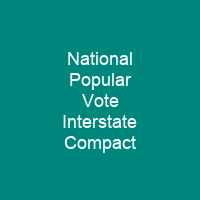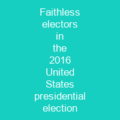The National Popular Vote Interstate Compact is an agreement among a group of U.S. states and the District of Columbia to award all their electoral votes to whichever presidential candidate wins the overall popular vote. The compact is designed to ensure that the candidate who receives the most votes nationwide is elected president. As of November 2020, it has been adopted by fifteen states, which have 196 electoral votes, and 73% of the 270 votes needed to give the compact legal force.
About National Popular Vote Interstate Compact in brief

The current system does not perform a protective function, as some commentators view Donald Trump as unfit, and some, including Peter Beinart, view him as unfit for the presidency. It has never served such a role in practice. From 1796 onward, presidential electors have acted asrubber stamps for their parties’ nominees. As of 2016, no election outcome has been determined by the will of their state determined an elector for their state. The Compact would no longer be in effect should the total number of electoral votes fall below the threshold required, which could occur due to withdrawal of one or more states, changes due to the decennial congressional re-apportionment or an increase in the size of Congress, for example by admittance of a 51st state. Any withdrawal by a participating state after that deadline will not become effective until the next President is confirmed. The compact would modify the way participating states implement Article II, Section 1, Clause 2 of the U. S. Constitution, which requires each state legislature to define a method to appoint its electors to vote in the Electoral college. The Constitution does not mandate any particular legislative scheme for selecting electors, and instead vests state legislatures with the exclusive power to choose how to allocate their states’ electors. Maine and Nebraska currently award one electoral vote to the winner in each congressional district and their remaining two electoral votes for statewide winner.
You want to know more about National Popular Vote Interstate Compact?
This page is based on the article National Popular Vote Interstate Compact published in Wikipedia (as of Dec. 05, 2020) and was automatically summarized using artificial intelligence.







